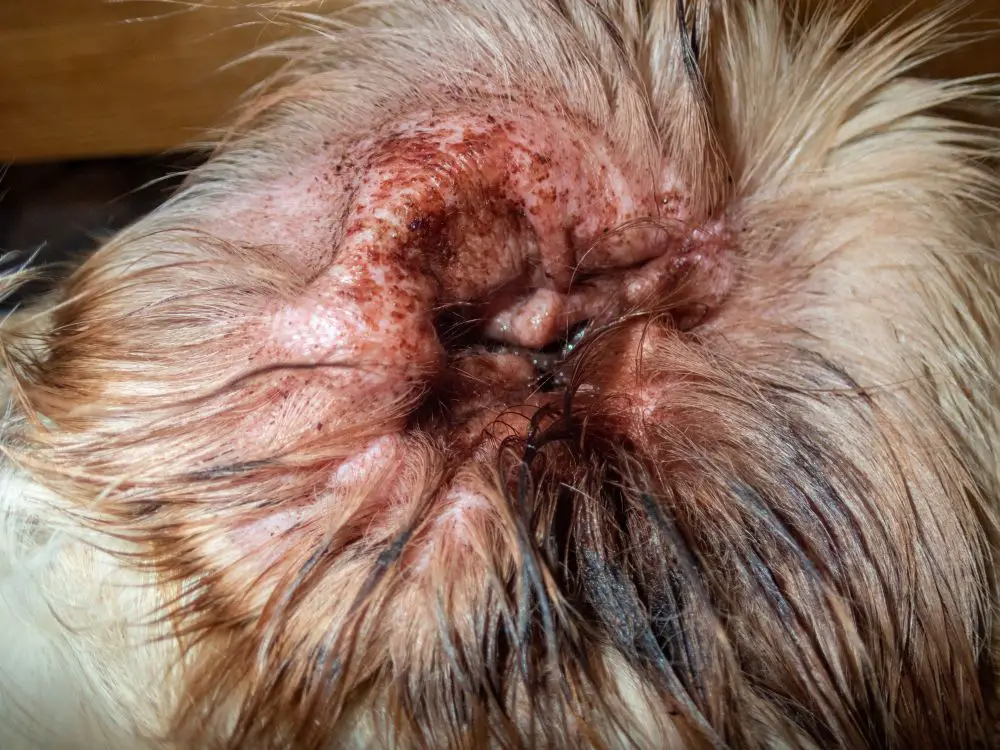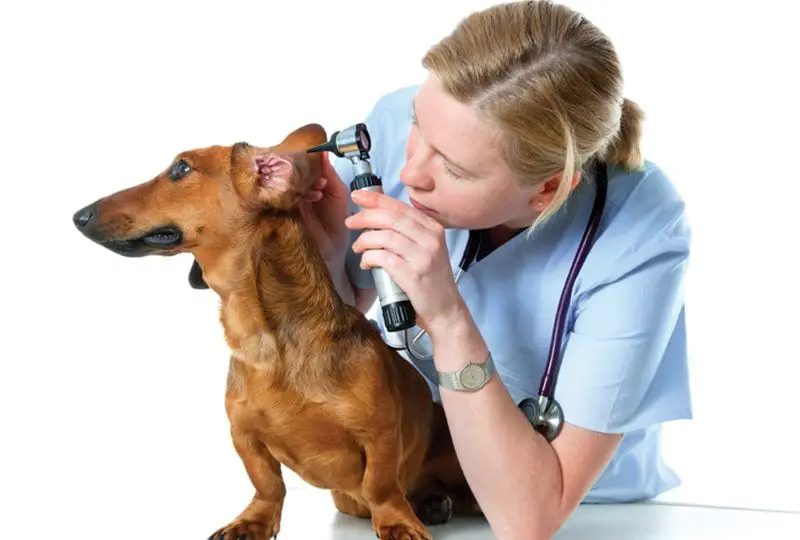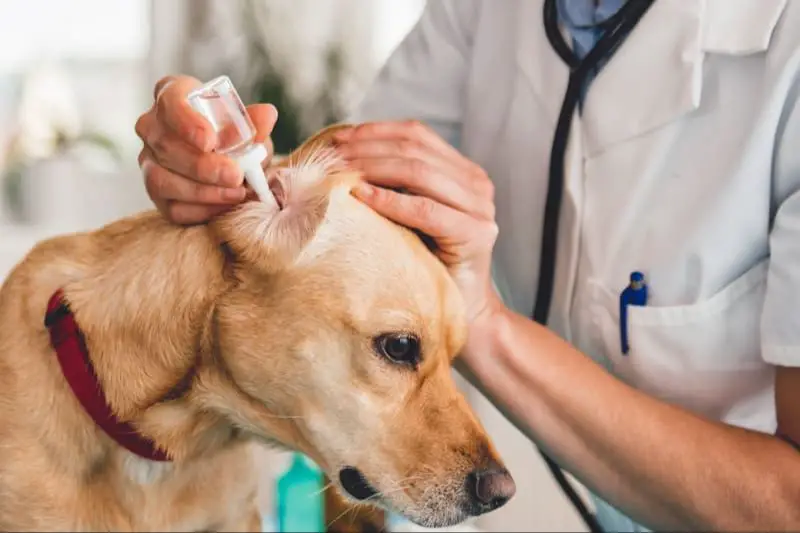Introduction
Ear infections are one of the most common medical issues that plague dogs. By some estimates, around 20% of dogs will suffer from an ear infection at some point in their lives. These painful infections can recur and lead to complications if left untreated.
The purpose of this article is to provide dog owners with a comprehensive overview of ear infections in dogs. We’ll cover the symptoms, causes, risk factors, diagnosis, and both at-home and veterinary treatment options for dog ear infections. We’ll also discuss how to safely use antibiotic ear drops to treat ear infections in dogs at home, and when it’s necessary to seek veterinary care.
Symptoms of Ear Infections in Dogs

The most common symptoms of an ear infection in dogs include head shaking and scratching at the ears. Dogs will often tilt or turn their head in the direction of the infected ear since it likely feels irritated. They may even walk in circles or have trouble finding their balance. Other symptoms include:
- Redness and inflammation in the ear
- Excessive wax buildup
- Foul odor coming from the ear
- Crusting or scabbing around the ear
- Hair loss around the ear
- Swelling of the ear flap or canal
- Shaking of the head or tilting it to one side
- Rubbing the ear on the floor or furniture
- Pain when the ear is touched
- Fluid draining from the ear
- Hearing loss
If your dog is exhibiting head shaking, ear scratching, or any other symptoms of an ear infection, it’s important to see your veterinarian. Left untreated, ear infections can become quite painful and cause permanent damage.
Causes of Ear Infections

There are several common causes of ear infections in dogs:
Allergies – Allergies to food, medications or environmental factors like pollen or dust mites can cause inflammation and irritation in the ear canal, leading to infection. Dogs with allergies produce excess ear wax which traps moisture and debris inside the ear.
Foreign Objects – Foreign materials like grass seeds, dirt, sand or plant awns getting lodged in the ear canal can obstruct the ear canal and cause trauma while the dog scratches at its ear. This can allow bacteria and yeast to enter and infect the irritated area.
Excess Moisture – Moisture trapped inside the ears creates the perfect environment for bacteria and yeast to thrive. Things like swimming, bathing, excessive ear wax, allergies or ear conformations that prevent adequate air flow can lead to excess moisture buildup in the ears.
Risk Factors
Certain breeds and lifestyles put dogs at an increased risk of developing ear infections. Breeds with floppy ears, like Basset Hounds, Cocker Spaniels, and Poodles are more prone to ear infections. The pendulous flap of their ears prevents air circulation and traps moisture, creating the perfect environment for infection. Dogs that swim frequently or get their ears wet often are also at a higher risk. The moisture and trapped water can irritate the ear canal and allow bacteria or yeast to overgrow.
In addition to breed and moisture, allergies and excess hair growth in the ear canal can set the stage for infection. Dogs with allergies produce more wax which plugs the ear canal. The allergies also cause inflammation which compromises the ear’s natural defenses. Some dogs, especially breeds like Poodles and Schnauzers, are prone to excessive hair growth inside their ear canals. This wiry hair traps moisture and debris which leads to inflammation and infection.
Diagnosing Ear Infections
If you suspect your dog has an ear infection, the first step is to take them to the veterinarian for a proper diagnosis. The vet will begin with a standard physical exam, checking for signs of irritation, inflammation, odor, and discharge in and around the ears.
They will then perform an otoscopic exam. This involves using an otoscope – a handheld instrument with a light and magnifying lens – to look inside the ear canal. Examining the ear canal and eardrum allows the vet to identify inflammation, foreign bodies, masses, and other abnormalities that may indicate infection.
Finally, the vet will often collect a sample of the material in the ear canal using a sterile swab. This sample will be sent for cytology, where it is stained and examined under a microscope. The presence of bacteria, yeast, and inflammatory cells can help confirm the type of infection present.
Combining the physical exam, otoscopic exam, and cytology allows the veterinarian to make an accurate diagnosis of ear infections in dogs.
Treatment Options
If your dog is diagnosed with an ear infection, there are several treatment options available that your veterinarian may recommend:
Antibiotic Ear Drops
Antibiotic ear drops are often the first line of treatment for ear infections in dogs. These prescription drops contain antibiotics that can treat bacterial and fungal infections. Some common antibiotics used include gentamicin, miconazole, and acetic acid. The drops help kill the infection-causing microbes inside your dog’s ears.

Your vet will show you how to properly administer the drops, which involves gently massaging the base of the ear after application to work the medication into the horizontal ear canal. It’s important to use the drops for the full course as prescribed, usually for 5-14 days.
Oral Antibiotics
For severe or chronic outer ear infections, your vet may prescribe oral antibiotics in addition to ear drops. These medications treat systemic bacterial infections and prevent the infection from worsening. Common oral antibiotics used for ear infections include amoxicillin, doxycycline, and cephalexin.
Anti-inflammatories
Steroids and nonsteroidal anti-inflammatory drugs (NSAIDS) may be prescribed to reduce swelling, inflammation, and pain caused by the infection. Reducing inflammation can help resolve the infection faster.
Getting Antibiotic Ear Drops
While there are some ear cleaners and drying agents available over-the-counter, antibiotic and anti-inflammatory ear drops require a prescription from your veterinarian. This is because the active ingredients in prescription ear drops can be toxic if used improperly or at too high of a dosage. Your vet needs to examine your dog’s ears, determine the type of infection, and prescribe the correct medication before you can obtain antibiotic ear drops.
Your vet may dispense the prescription ear drops directly from their office. More often, they will provide a written prescription you can fill at your regular pharmacy. Be sure to follow the label instructions carefully, including how many drops to administer and how often. Never use leftover medication from a prior infection without consulting your vet first.
Do not attempt to purchase antibiotic ear drops online without a valid prescription. Many online pharmacies advertise pet medications without requiring a prescription, but this practice is illegal and potentially dangerous. Only give your dog medications that have been specifically prescribed by your vet for the current ear infection. The wrong medication or incorrect use can worsen the infection or damage the ear canal.
Using the Ear Drops
It is crucial to use the antibiotic ear drops exactly as directed by your veterinarian. The dosage amount and frequency will depend on your dog’s specific infection and level of discomfort. Typically, several drops are administered into the affected ear canal 1-3 times per day. Before each use, gently clean any discharge or debris from your dog’s ear with a cotton ball or pad soaked in mineral oil or an ear cleaning solution recommended by your vet. This will allow the medication to reach the infected area. Massage the base of the ear after putting in drops to help work the medication into the ear canal. Follow up with your veterinarian if you do not see improvement within the expected timeframe, as a different medication may be needed. With proper administration and veterinary guidance, antibiotic ear drops can effectively treat many common ear infections in dogs.
Preventing Ear Infections
One of the best ways to prevent painful ear infections in dogs is to keep their ears clean and dry. Be sure to gently wipe out the ears weekly with a cotton ball dampened with a veterinarian-approved cleanser to remove any wax or debris buildup. Avoid inserting cotton swabs deep into the ear canal, as this can damage the delicate skin and push wax deeper inside.

Also, be vigilant about drying your dog’s ears thoroughly after swimming or bathing. Trapped moisture creates the perfect environment for infection-causing bacteria and yeast to thrive. Consider placing a couple drops of drying solution in the ears after water activities.
Treating underlying allergies is another important preventive step. Allergies to foods, pollen, mold and other environmental triggers can cause inflammation and irritation. Work with your veterinarian to identify and control allergy symptoms through medications, hypoallergenic diets or other methods. Keeping allergies under control will go a long way in keeping ears healthy.
With proper at-home ear care and allergy management, you can help avoid frustrating ear infections in your dog. But be sure to see the veterinarian promptly if symptoms do arise, as some ear infections can advance quickly. Preventing infections through proactive ear cleaning and allergy control is much easier than treating a painful infection after it has already set in.
When to See the Vet
If your dog’s ear infection does not improve after 5-7 days of antibiotic ear drop treatment, you should make an appointment to see your veterinarian. Persistent ear infections that do not respond to medication may indicate an underlying problem that requires further diagnosis and treatment.
Some signs that it’s time for a vet visit include:
- No decrease in head shaking, scratching or signs of discomfort after using drops for 5-7 days
- Worsening redness, swelling, odor or discharge from the ears
- Development of new symptoms like balance issues or head tilt
- Presence of wounds or sores in or around the ears
Seeing your vet allows them to re-examine your dog’s ears, determine if the current medication is appropriate, and prescribe a different medication if needed. They can also rule out the possibility of a more serious illness causing the persistent infection. Getting the right diagnosis and treatment will provide your dog relief and prevent prolonged misery. Do not allow ear infections to go untreated.